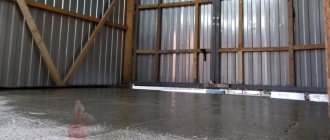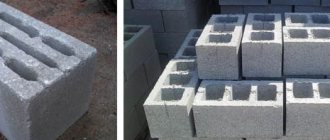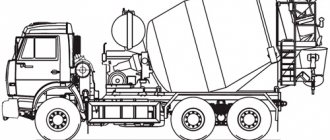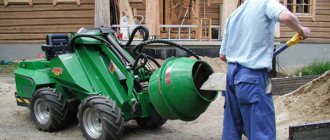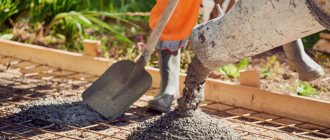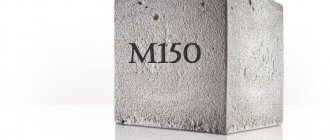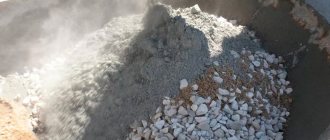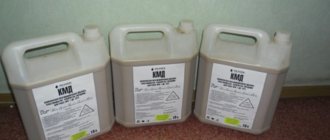Anyone who has mixed a concrete mixture at least once knows how labor-intensive, physically difficult and lengthy this process is. For high-quality work, the solution must be uniform and of the correct consistency. Therefore, you have to knead it long and thoroughly.
Household portable faucets greatly simplify work and save time. How to use a concrete mixer? It would seem that there is nothing complicated about this - an ordinary manual or electrical device.
This is not entirely true since there are certain rules for operating this unit and they should be followed for safety reasons and to ensure that the device lasts longer. Regardless of brand, model and manufacturer.
Operating Features: Tips and Cautions
What is preserving a mixer and how to do it correctly. Main malfunctions and causes of their occurrence.
How the device works
The concrete mixer has been used by construction crews at sites for many years, replacing physical labor and saving time.
Loading ingredients into a concrete mixer
The appearance of the device resembles a large barrel (drum) with a slight slope in a frame (frame) with the top open.
The drive of the unit can be manual or electric.
The number of varieties is huge. All types belong to a certain class based on the principle of operation.
The simplest and most popular model with built-in blades inside the drum. They are the ones who mix the components that make up the concrete mixture.
Concrete mixers with forced mixing
Unlike gravity concrete mixers, they produce high-quality concrete in a shorter time. To make it more clear: if you pour sugar into tea, no matter how hard you twist the cup, it will not become sweet quickly, but if you stir it with a spoon (forcibly), the tea will become sweet almost immediately. Most often, forced concrete mixers come in this design: a trough-shaped container with a horizontal shaft or a cylindrical container with a vertical shaft.
Concrete mixers with a horizontal shaft are characterized by excellent mixing, which is why concrete is often used for vibratory casting of the highest quality (for example, for the production of paving stones). The disadvantage of such concrete mixers is that it is difficult to unload from the mixer. Concrete mixers with a vertical shaft have a unique design. They have blades attached to the shaft: closer to the center - mixing blades, at the edges - selection blades. The mixing solution is mixed, the selected solution is scraped off the walls of the container. The fractions may be larger than in the mixture for horizontal shafts, but there is a risk of the concrete mixer jamming. There are other disadvantages:
- - high cost of the unit;
- - high energy consumption.
Fiber fiber cannot be added to these types of concrete mixers in any way; this is not effective, since it will be mechanically destroyed. But they are used to produce dry construction mixtures, since they mix dry ingredients well.
Basic rules for working with a mixer
Specialty hardware stores carry many brands of concrete mixers for everyday use. Their design is quite trivial. The principle of mixing is most often gravitational; it is driven by transmission belts or a gear ring to an electric motor. The power consumption of the device is 700W.
The drum volume is on average (according to the standard) 160 liters. The mass of the concrete mixture is produced in it according to standard standards - this is 2/3 of the total contents, which is equal to 100 liters of ready-made concrete. How to use a concrete mixer at home?
The answer is obvious and simple - strictly according to the instructions. Violation of these rules and requirements is fraught with a reduction in service life or even failure.
Vortex concrete mixers
They also belong to forced-type concrete mixers.
The structure and essence are as follows: a rotor is installed in the center of a cylindrical container, in the lower part of the container there is a conical bottom with a discharge disk. The rotor, which operates at up to 750 rpm, creates a vortex mixing, thanks to which the mixture is mixed very well, the concrete becomes homogeneous, and the fractions do not settle or separate. Energy consumption is not high, since it is not the rotor that mixes, but the medium disturbed by vortex flows. You can even add fiber to such a mixer, it will not be destroyed. It could collapse due to mechanical mixing, but here, just think, it’s just a disturbance of the environment. The disadvantage of such a concrete mixer is that it is impossible to produce rigid concrete with large fillers.
Instructions for making concrete mixture at home
Connection
Before you start using a concrete mixer at home, determine the location of the electric current supply tee. It must be secure, connect to the network. If the concrete mixer is gasoline, fill it up and check that the tank cap is tightly closed. Strictly follow safety precautions.
Installation of the device
Add water
The concrete mixer should be placed on a flat, hard, horizontal surface.
Near the place where concrete mixture is used on a construction site.
Fix the device firmly and check the brakes on each wheel separately.
Install the stabilizing lock in its proper place.
Before starting the mixing process, the benton mixer is checked at zero load. And only after that they begin to work under load.
Lifting the container
The horizontal inclination angle of the drum during mixing should be about 35 degrees. Move the container to the desired position and secure it.
Preparation of concrete
Loading and (or) unloading of mixture components must be done exclusively with the drum in circulation. Otherwise the engine may fail.
To prepare a concrete mixture, you need to pour in some water, then add cement and then add successively: sand, crushed stone or gravel.
Set the speed control relay to the lowest setting. Initially, the machine should operate at low speeds so that the sand, crushed stone or gravel with cement is mixed to a homogeneous mass.
Then switch to medium speed. Pour in the rest of the water. Fill the liquid with a bucket, not with a hose (it can get inside and be pulled in).
Starting a concrete mixer when the drum is turned off is prohibited! Loading the drum of the device, according to technology, is done manually.
Concrete mixers
Time flies. There are more and more people on Earth, and everyone needs housing. It is no longer only creeping in breadth, but also climbing upward: there is not enough space, especially in cities. If you don’t build a high-rise building out of wood, natural disasters will demolish it. The walls are made of stone and concrete. Concrete does not exist in nature; it must be obtained by combining gravel, sand, cement and water. Until the houses grew upward, there was enough concrete, which the builders mixed with a shovel. In multi-story construction, so much concrete is used that not only the builders, but also the foremen, foremen, engineers, and the entire senior management team are not enough to mix it. So the mechanisms that mix concrete have developed.
Shutdown
The concrete mixture, ready for use, must be homogeneous (homogeneous), of medium consistency. Unloading is performed with a rotating container (drum). Loosen the lock slightly and tilt the neck down. The concrete will flow out into the container prepared for it. After the contents are unloaded, the drum moves to the loading position to repeat the cycle.
Cleaning the machine
Some faucet owners neglect this procedure. This should not be done because such an attitude towards the device affects its performance and performance. After completion of work, the drum must be cleaned. To do this, turn it upside down and rinse with water. If this is not done in time, the concrete inside the car will harden and it will simply be impossible to get it out of there.
This step is mandatory, perform it very carefully. Do not hit the drum with metal objects in order to knock off concrete residues stuck to its surface. When washing the car, the electricity must be turned off. Try to wash so that water does not get into the inside of the electric motor. Cover it with cellophane or other material before washing.
Lubrication of a pair of gears and a ring gear to prevent premature wear is strictly prohibited.
Which direction should the concrete mixer rotate?
A concrete mixer, or concrete mixer, is a specialized construction machine designed for preparing concrete and other solutions used for pouring foundations, screeds, brickwork, as well as gluing tiles, and so on. Concrete mixers are an open-top container into which concrete components - cement, sand, gravel and water - are poured. By stirring, the device prepares a solution, which, using a special mechanism, is conveniently poured into a placed container.
Operating Features: Tips and Cautions
- When working with cement, put on a respirator before opening the bag. Do not remove it until work is completed. This way you will protect your respiratory organs from penetration of cement dust.
- Portable faucets are connected to the electrical network using a special wire cable. It is not included in all models. Instead, the machine is equipped with a plug and a short wire.
- The operation of the mixer is cyclical: loading components into the machine, mixing the contents, unloading the finished concrete mixture, stopping the motor completely.
- You need to plug in the machine with the drum neck in a vertical position. Loading of components is carried out with a revolving drum. The components are poured in by hand. It is not recommended to do this with a shovel or other equipment because there is a possibility of scratching the painted surface of the tank, which means it will have to be painted over later.
- All components, according to the technology, must be poured into the machine in the following order: part of the water, cement sand, construction sand or regular sand, gravel or crushed stone, the rest of the water.
- If the sequence is broken, then sand or cement will simply stick to the surface of the drum. The machine will not be able to mix the mixture evenly. This means that the consistency of the concrete mixture will be compromised.
- Make sure that the horizontal tilt angle of the drum is no more and no less than 30 degrees. This is required by the instructions according to calculations, technology and engineering studies.
Reducing the angle of inclination improves the quality of mixing, but reduces its volume. Increasing - will increase the volumes, but will reduce the quality of mixing the components.
- Do not overload the drum. It's better to do several cycles in a row. This will increase the service life of the device. In the instructions for using the device, the weight norm for loading components is always indicated. Don't neglect these requirements.
- The optimal preparation time for the finished solution or one cycle is approximately 3 minutes. If you add up to 4 minutes, the concrete mixture is simply centrifuged, which will negatively affect its quality.
- Under no circumstances should the engine housing of the device be covered with anything. Otherwise you will damage the cooling system. Which will cause wear on the unit. If the electric motor overheats, the thermal relay will automatically turn off the machine and stop the machine. You can turn it on again after the engine has cooled down a little.
How to use a concrete mixer correctly - the video clip attached to the material will show everything with a clear example:
Gravity concrete mixers
In principle, everyone knows and has seen them.
A pear rotating on small construction sites with a characteristic grinding sound is an example of a gravity concrete mixer. In addition to the pear, the main components are the engine and the tipping mechanism. Why is this concrete mixer called gravity? When mixing all the components, the blades welded inside the pear prevent the concrete from sliding and lift it. Due to gravity, at the point where the top point is reached, part of the mixture located on the blade falls into the bulk of the solution. This is the effect of gravity. This is how mixing occurs. How well will the concrete be mixed? This depends on the speed and angle of the pear, as well as the number of blades. Advantages of gravity concrete mixers:
- - relatively low price;
- — their range is wide in terms of batch volume;
- — reliability and simplicity of design combined with low weight and fairly significant volumes of concrete production;
- — mixtures are mixed even with cobblestones larger than 10 cm in size;
- - low power consumption.
- — a homogeneous mixture is obtained with prolonged stirring;
- — fiber fibers (used for concrete reinforcement) and pigments are distributed unevenly;
- — fine-grained solutions are not mixed effectively.
